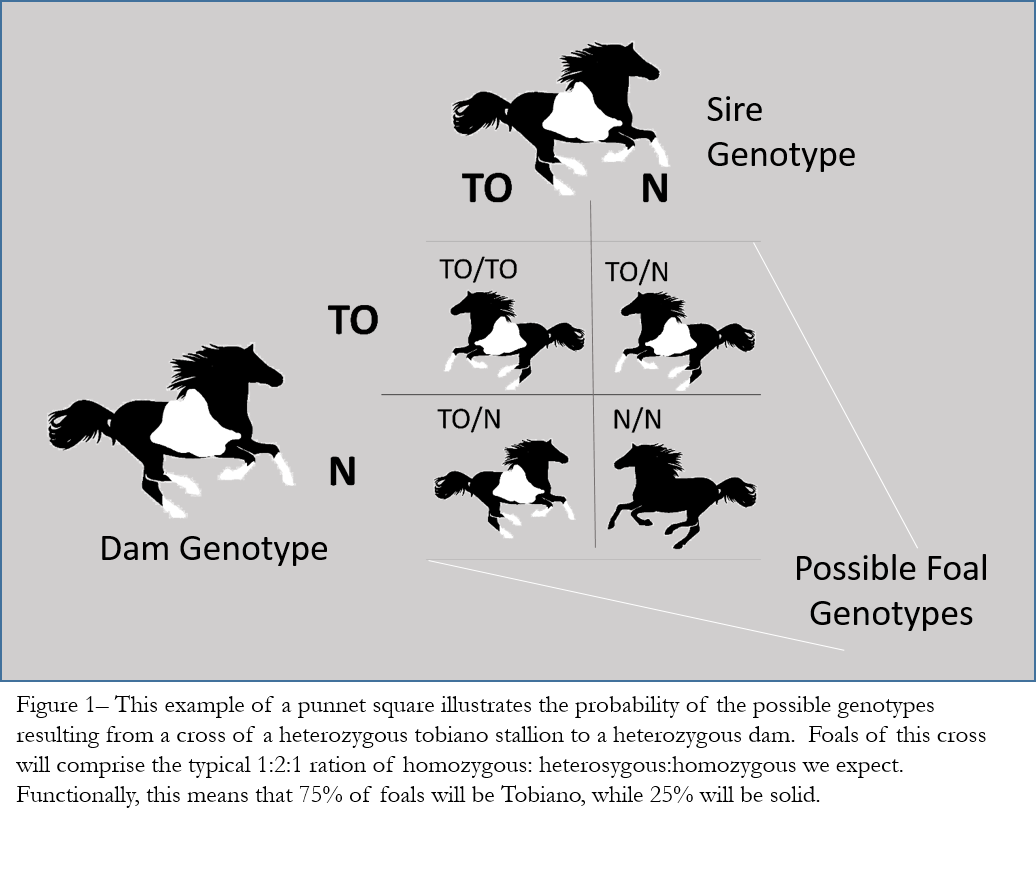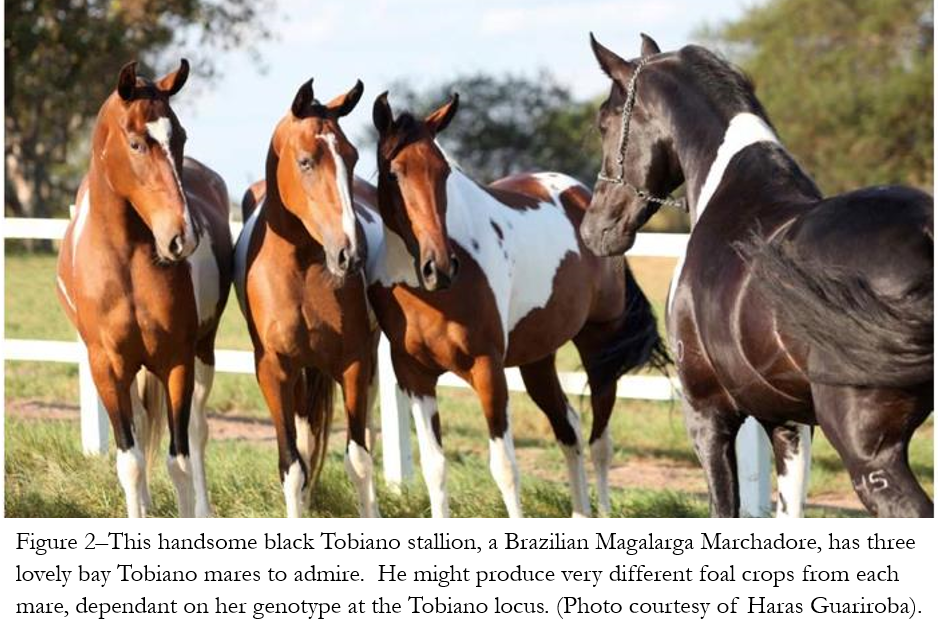Color is among some of the earliest traits we selected in newly domesticated species (1). Today, color can be critical for registration and therefore, the value of our horses. For example, in breeds like the Friesian (which requires true black) and the exotic Mangalarga Marchador (which does not allow cremellos or perlinos) color is more than an aesthetic preference, it is a breed requirement. Indeed, on average, presence of a spotting pattern doubles the value of an APHA foal. For example, in 2006, the average price of an American Paint Horse Association (APHA) registered yearling without a spotting pattern was $1540, while a yearling APHA registered horse with the tobiano pattern averaged $2803 (2).
Pedigrees can be helpful, but are only estimates of the genetic content of a horse. For recessive single gene traits like many of our coat colors, it is not uncommon to produce foals that look nothing like their parents, or their grandparents. Examining the phenotype, or apparent color of a horse is also not an accurate approach. Epistatic effects, or an interaction of genes, can mask some coat colors and patterns. Finally, the classification of a given color or pattern phenotype is rarely standardized for records. Some breeds classify any pattern or color with a similar appearance with the same nomenclature. This can cause confusion when attempting to produce or eliminate the trait in the foal crop. In these cases, genetic testing is necessary to reveal the possibility of a recessive or ambiguous coat pattern among the parents’ genotypes.
 Tests exist for approximately 50 different genotypes for colors and patterns in the horse, with more discovered each year. Individual testing companies may not offer all tests, and some companies may offer tests that do not directly detect the causative mutation for a given color. Consumers are advised to read documentation carefully when purchasing genetic diagnostics and be sure to use a reputable company. Genetic testing results can be used to very accurately predict the likelihood of a possible color in an expected foal, and if that’s your focus, provide a better tool to select for breedings that will achieve your desired coat color. Given a desired color for a future foal and known genotypes for the dam, it is a fairly simple to use the genotypes of prospective stallions to choose the sire that will give you the best probability of getting what you want, one trait at a time (Figure 1).
Tests exist for approximately 50 different genotypes for colors and patterns in the horse, with more discovered each year. Individual testing companies may not offer all tests, and some companies may offer tests that do not directly detect the causative mutation for a given color. Consumers are advised to read documentation carefully when purchasing genetic diagnostics and be sure to use a reputable company. Genetic testing results can be used to very accurately predict the likelihood of a possible color in an expected foal, and if that’s your focus, provide a better tool to select for breedings that will achieve your desired coat color. Given a desired color for a future foal and known genotypes for the dam, it is a fairly simple to use the genotypes of prospective stallions to choose the sire that will give you the best probability of getting what you want, one trait at a time (Figure 1).
Tobiano is an excellent example of a well-studied spotting pattern that is easily selected for using genetic testing (3; Figure 2). Suppose you desire a Black Tobiano foal. You have three nice bay Tobiano mares and have selected a handsome Tobiano stallion, but which mare is most likely to give you the foal you want? You study the stallions genotype using data provided by the stallion owner and discover that he is homozygous for black and heterozygous for Tobiano. That’s a good start. Depending on the genotype of your mares the probability of producing a Tobiano foal can still vary from 75% if she heterozygous to 100% if she’s homozygous. For the Black base coat color the frequency might vary from 0% in mares that don’t carry a Black allele to 50% if she possess one Black allele (hidden in this case by a dominant Bay allele giving her the apparent Bay phenotype.) To determine the likelihood of the combination of the two in a Black Tobiano you simply multiply the probabilities. Thus, your choice of mare has the potential to change the chances you get the color of foal you want from 0 to 50%. To meet a need as simple as a color preference in your next personal riding horse perhaps this degree of inaccuracy is quite tolerable. However, to the commercial breeder leaving these decisions to chance can have a significant negative impact on profits.
It is important to bear in mind that some of our coat color genes are also associated with genetic diseases or undesirable traits. For that reason, testing your horse can provide answers to crucial questions – is this pattern I see Sabino or Frame Overo? That’s just one example of two commonly confused phenotypes. Frame Overo results in Overo Lethal White Foal Syndrome in the homozygous state (4). In contrast, Sabino 1 homozygotes are healthy, though they may have a very white coat (5). Similarly, the Leopard (i.e. Appaloosa pattern) homozygote is affected by Congenital Stationary Night Blindness, although this condition is quite survivable and most affected horses adapt to this congenital impairment of vision (6). Understanding of the genotypes for both parents and the at-risk genotypes in future breedings is critical to avoid sick foals, neo-natal death and lost pregnancies due to conditions related to valuable coat color loci.
 Of course there are still yet unknown genetic variables in horse coat color. We have yet to understand why some patterns, even those as strongly dominant as Tobiano, will still occasionally produce exceptions; individuals who possess far less, or far more, than the average expression of the pattern. Ultimately, although a pattern gene will confer the necessary conditions for the pattern phenotype, where those spots end up is still a game of chance. Melanocytes (or in its early form, the melanoblast), cells responsible for color production, have a well-known sequence of migration and expansion during development of the embryo (7). Advancing mainly from the neural crest, they are deposited all along the epidermis and on the hair follicles later in development. Alleles causing white patterns in horses disrupt melanocyte migration pathways, giving origin to a myriad of patterns of white where these pigment cells have failed to populate. No genetic mechanism can completely explain where these spots will end up and to some degree breeding for spotting patterns will always be a game of chance.
Of course there are still yet unknown genetic variables in horse coat color. We have yet to understand why some patterns, even those as strongly dominant as Tobiano, will still occasionally produce exceptions; individuals who possess far less, or far more, than the average expression of the pattern. Ultimately, although a pattern gene will confer the necessary conditions for the pattern phenotype, where those spots end up is still a game of chance. Melanocytes (or in its early form, the melanoblast), cells responsible for color production, have a well-known sequence of migration and expansion during development of the embryo (7). Advancing mainly from the neural crest, they are deposited all along the epidermis and on the hair follicles later in development. Alleles causing white patterns in horses disrupt melanocyte migration pathways, giving origin to a myriad of patterns of white where these pigment cells have failed to populate. No genetic mechanism can completely explain where these spots will end up and to some degree breeding for spotting patterns will always be a game of chance.
The minimal (or “crypto) effect on Tobiano produces a horse with little to no pattern, despite the typical Tobiano genotype effect. In the US this modifier appears to be rare, but it is frequently observed in the Hucul, a breed native to the East Carpathian Mountains of Europe. Some Hucul horses homozygous for the Tobiano mutation possess almost no white markings to visually differentiate them from a solid colored horse (8). Although genetically homozygous for Tobiano, an unknown genetic mechanism compensated for the Tobiano mutation, allowing the melanocytes to distribute across most of the body. These crypto-Tobiano individuals were capable of producing both the typical and minimal Tobiano patterns in their offspring. Thus there still much work to be done to perfect our ability to predict coat color in a foal.
Currently, shopping for a stallion with the right genotype requires significant research on the part of the mare owner in order to compile genetic profiles of potential studs. Public databases of genotypes on prospective stallions do not yet exist the way they do for dairy and beef cattle bulls. With luck, online databases and calculators will make the process easier for the horse industry in the near future.





